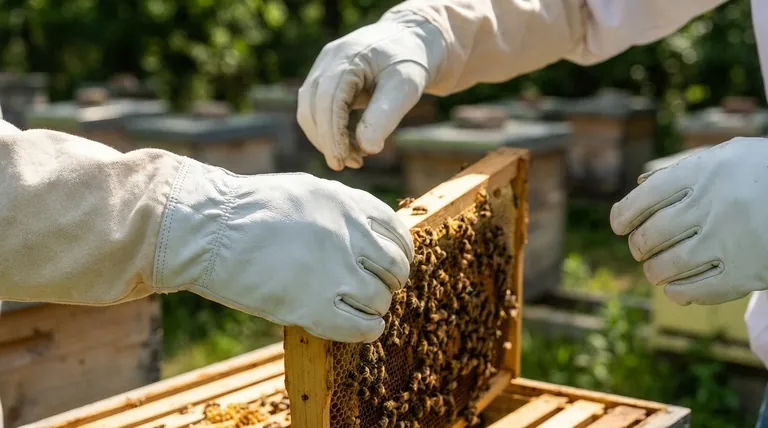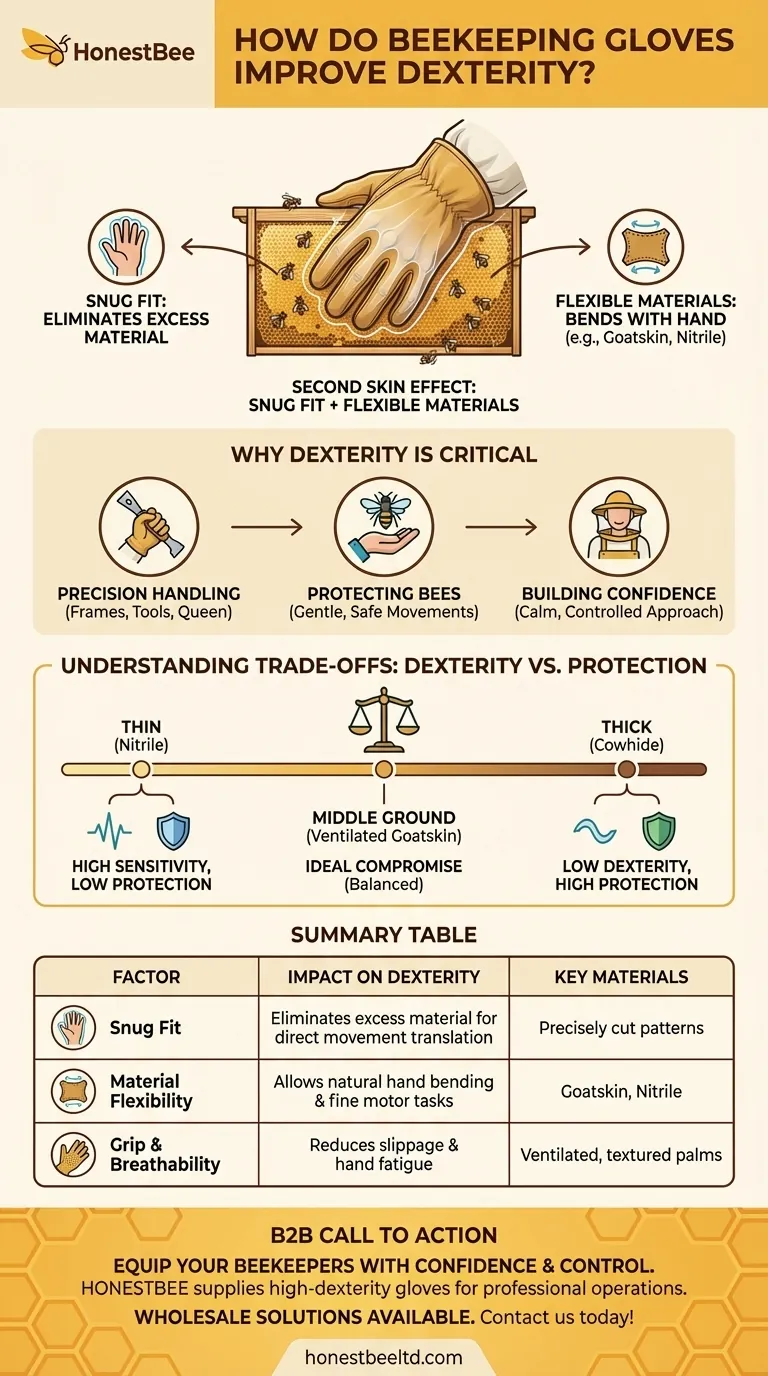Beekeeping gloves improve dexterity primarily through a snug fit and the use of flexible materials. Rather than adding a complex feature, a well-designed glove acts as a second skin, eliminating excess material that would otherwise bunch up and hinder movement. This allows your fingers to move precisely, providing the tactile feedback needed to handle delicate frames and tools without harming the bees.
The core challenge in beekeeping glove design is balancing protection against stings with the dexterity required for gentle hive manipulation. The most dexterous gloves achieve this by minimizing the barrier between your hand and your work, a goal accomplished through superior fit and material choice.

Why Dexterity is Critical in Beekeeping
Working inside a beehive is not a task of brute force; it requires deliberate, careful movements. Poor dexterity can lead to clumsy mistakes that can harm the colony and result in more stings for the beekeeper.
Handling Frames and Tools with Precision
Hive inspections require you to lift and manipulate frames, use a hive tool to separate components, and perform delicate tasks like marking a queen. Dexterous gloves allow you to grip these items securely and move them with control.
Protecting Your Bees
A clumsy grip can be disastrous. Dropping a frame or accidentally crushing bees will not only kill them but can also trigger a defensive response from the rest of the colony. Good dexterity allows you to work gently and safely.
Building Beekeeper Confidence
When you can feel what you're doing, you work with more confidence and less hesitation. This calm, controlled approach is less disruptive to the bees and makes the entire experience more effective and enjoyable.
The Anatomy of a Dexterous Glove
The feeling of dexterity comes from a combination of factors that work together to make the glove feel like an extension of your hand.
The Critical Importance of a Snug Fit
A glove should be snug but not tight. Any loose material at the fingertips or palm will fold and get in the way, completely destroying your ability to perform fine motor tasks. A proper fit ensures your every movement is translated directly to the glove's surface.
The Role of Material Flexibility
Thin, pliable materials like goatskin leather or nitrile are popular choices for dexterous gloves. They bend and flex with your hand's natural movements, unlike thick, stiff cowhide which can feel like you're wearing boards on your hands.
Reducing Slippage and Fatigue
Dexterity is also about maintaining control over time. Gloves made with breathable materials prevent your hands from sweating excessively. This reduces the risk of tools slipping and minimizes fatigue during long inspections.
Understanding the Trade-offs: Dexterity vs. Protection
Choosing a beekeeping glove is always an exercise in managing trade-offs. You must decide where you fall on the spectrum between maximum sensitivity and maximum protection.
Thinner Gloves, Higher Sensitivity
Gloves like disposable nitrile offer the highest level of dexterity, allowing you to feel nearly everything. However, they offer very little protection, and bee stings can easily penetrate the material.
Thicker Gloves, Maximum Protection
Heavy-duty cowhide leather gloves provide the most robust protection against stings. This security comes at a great cost to dexterity, making delicate work nearly impossible. They are best reserved for handling highly aggressive colonies.
Finding the Middle Ground
For most beekeepers, ventilated goatskin gloves represent the ideal compromise. They are thick enough to provide reliable sting protection but remain flexible enough for good dexterity during routine hive inspections.
Making the Right Choice for Your Goal
Your ideal glove depends on your personal comfort level with bees and the specific task you need to accomplish.
- If your primary focus is maximum sensitivity for delicate tasks: Consider using thin nitrile gloves, but understand and accept the higher risk of stings.
- If your primary focus is a balanced approach for routine inspections: Snug-fitting goatskin gloves offer the best all-around combination of dexterity and reliable protection.
- If your primary focus is absolute protection during aggressive hive work: Thick cowhide gloves are the safest choice, but be prepared for a significant loss of fine motor control.
Ultimately, the right glove is the one that empowers you to work calmly, confidently, and safely within your hive.
Summary Table:
| Factor | Impact on Dexterity | Key Materials |
|---|---|---|
| Snug Fit | Eliminates excess material for direct movement translation | Precisely cut patterns |
| Material Flexibility | Allows natural hand bending and fine motor tasks | Goatskin, Nitrile |
| Grip & Breathability | Reduces slippage and hand fatigue during long tasks | Ventilated, textured palms |
Equip your beekeepers with confidence and control. For commercial apiaries and distributors, the right gloves are essential for efficiency and safety. HONESTBEE supplies high-dexterity beekeeping gloves and equipment designed for professional use. Enhance your operations with our wholesale-focused solutions—contact our team today to discuss your needs!
Visual Guide

Related Products
- Beekeeping Gloves Goatskin Leather with Long Cotton Sleeve for Beekeepers
- Goatskin Leather Beekeeper Gloves with Vent Long Sleeve for Beekeeping Honey Bee Sting Proof Protection
- Goat Skin Leather Bee Sting Proof Beekeeping Gloves with Canvas Sleeve
- Mesh Ventilated 3 Layer Goatskin Beekeepers Gloves for Beekeeping
- Professional Drop-Style Hive Handles for Beekeeping
People Also Ask
- What should beekeepers consider regarding the fit of beekeeping gloves? Achieve Safety and Dexterity
- Why are protective gloves important in beekeeping? Boost Confidence & Safety in Your Apiary
- Should beekeepers wear gloves, and why? Essential Protection for Beekeepers
- Why do some experienced beekeepers choose not to wear gloves? For Superior Dexterity & Hive Welfare
- What are the advantages of goatskin leather gloves for beekeeping? Superior Sting Protection for Your Apiary



















